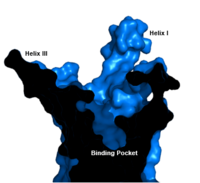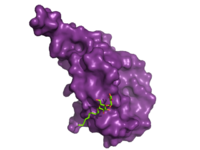Sandbox Reserved 1167
From Proteopedia
(Difference between revisions)
| Line 20: | Line 20: | ||
However, one particular difference between class A receptors and class B receptors is an inward shift of the intracellular component of Helix VII. In class A receptors this inward shift is instrumental in receptor activation, yet in class B receptors it remains unclear what role this shift plays<ref name ='structure_article'>PMID:23863937</ref>. | However, one particular difference between class A receptors and class B receptors is an inward shift of the intracellular component of Helix VII. In class A receptors this inward shift is instrumental in receptor activation, yet in class B receptors it remains unclear what role this shift plays<ref name ='structure_article'>PMID:23863937</ref>. | ||
| - | In contrast to class A glucagon receptors which have a [https://en.wikipedia.org/wiki/Proline proline] kink, in all [https://en.wikipedia.org/wiki/Secretin_receptor_family secretin-like class B glucagon receptors] a [https://en.wikipedia.org/wiki/Glycine Glycine] at position 393 in Helix VII allows for a <scene name='72/721537/Gly_393_helical_bend/ | + | In contrast to class A glucagon receptors which have a [https://en.wikipedia.org/wiki/Proline proline] kink, in all [https://en.wikipedia.org/wiki/Secretin_receptor_family secretin-like class B glucagon receptors] a [https://en.wikipedia.org/wiki/Glycine Glycine] at position 393 in Helix VII allows for a <scene name='72/721537/Gly_393_helical_bend/3'>helical bend</scene>. This glycine helical bend is fully [https://en.wikipedia.org/wiki/Conserved_sequence conserved] in all secretin-like class B receptors. |
Another important structural component found in all secretin-like class B receptors are the two conserved [https://en.wikipedia.org/wiki/Salt_bridge_%28protein_and_supramolecular%29 salt bridges] found between [https://en.wikipedia.org/wiki/Arginine Arg] 346 and [https://en.wikipedia.org/wiki/Glutamic_acid Glu] 406 and Arg 173 and Glu 406. These <scene name='72/721537/Salt_bridges/2'>salt bridges</scene> are a distinct feature of class B receptors because their interaction results in the distinct stalk found only in class B receptors<ref name ='structure_article'>PMID:23863937</ref>. | Another important structural component found in all secretin-like class B receptors are the two conserved [https://en.wikipedia.org/wiki/Salt_bridge_%28protein_and_supramolecular%29 salt bridges] found between [https://en.wikipedia.org/wiki/Arginine Arg] 346 and [https://en.wikipedia.org/wiki/Glutamic_acid Glu] 406 and Arg 173 and Glu 406. These <scene name='72/721537/Salt_bridges/2'>salt bridges</scene> are a distinct feature of class B receptors because their interaction results in the distinct stalk found only in class B receptors<ref name ='structure_article'>PMID:23863937</ref>. | ||
Revision as of 12:45, 19 April 2016
| This Sandbox is Reserved from Jan 11 through August 12, 2016 for use in the course CH462 Central Metabolism taught by R. Jeremy Johnson at the Butler University, Indianapolis, USA. This reservation includes Sandbox Reserved 1160 through Sandbox Reserved 1184. |
To get started:
More help: Help:Editing |
Class B Human Glucagon G-Protein Coupled Receptor
References
- ↑ 1.0 1.1 1.2 1.3 1.4 1.5 1.6 Siu FY, He M, de Graaf C, Han GW, Yang D, Zhang Z, Zhou C, Xu Q, Wacker D, Joseph JS, Liu W, Lau J, Cherezov V, Katritch V, Wang MW, Stevens RC. Structure of the human glucagon class B G-protein-coupled receptor. Nature. 2013 Jul 25;499(7459):444-9. doi: 10.1038/nature12393. Epub 2013 Jul 17. PMID:23863937 doi:10.1038/nature12393
- ↑ 2.0 2.1 2.2 Hollenstein K, de Graaf C, Bortolato A, Wang MW, Marshall FH, Stevens RC. Insights into the structure of class B GPCRs. Trends Pharmacol Sci. 2014 Jan;35(1):12-22. doi: 10.1016/j.tips.2013.11.001. Epub, 2013 Dec 18. PMID:24359917 doi:http://dx.doi.org/10.1016/j.tips.2013.11.001
- ↑ 3.0 3.1 Yang L, Yang D, de Graaf C, Moeller A, West GM, Dharmarajan V, Wang C, Siu FY, Song G, Reedtz-Runge S, Pascal BD, Wu B, Potter CS, Zhou H, Griffin PR, Carragher B, Yang H, Wang MW, Stevens RC, Jiang H. Conformational states of the full-length glucagon receptor. Nat Commun. 2015 Jul 31;6:7859. doi: 10.1038/ncomms8859. PMID:26227798 doi:http://dx.doi.org/10.1038/ncomms8859
- ↑ 4.0 4.1 Koth CM, Murray JM, Mukund S, Madjidi A, Minn A, Clarke HJ, Wong T, Chiang V, Luis E, Estevez A, Rondon J, Zhang Y, Hotzel I, Allan BB. Molecular basis for negative regulation of the glucagon receptor. Proc Natl Acad Sci U S A. 2012 Sep 4;109(36):14393-8. Epub 2012 Aug 20. PMID:22908259 doi:http://dx.doi.org/10.1073/pnas.1206734109
- ↑ Mukund S, Shang Y, Clarke HJ, Madjidi A, Corn JE, Kates L, Kolumam G, Chiang V, Luis E, Murray J, Zhang Y, Hotzel I, Koth CM, Allan BB. Inhibitory mechanism of an allosteric antibody targeting the glucagon receptor. J Biol Chem. 2013 Nov 4. PMID:24189067 doi:http://dx.doi.org/10.1074/jbc.M113.496984
- ↑ Mittermayer F, Caveney E, De Oliveira C, Gourgiotis L, Puri M, Tai LJ, Turner JR. Addressing unmet medical needs in type 2 diabetes: a narrative review of drugs under development. Curr Diabetes Rev. 2015;11(1):17-31. doi: 10.2174/1573399810666141224121927. PMID:25537454 doi:http://dx.doi.org/10.2174/1573399810666141224121927


